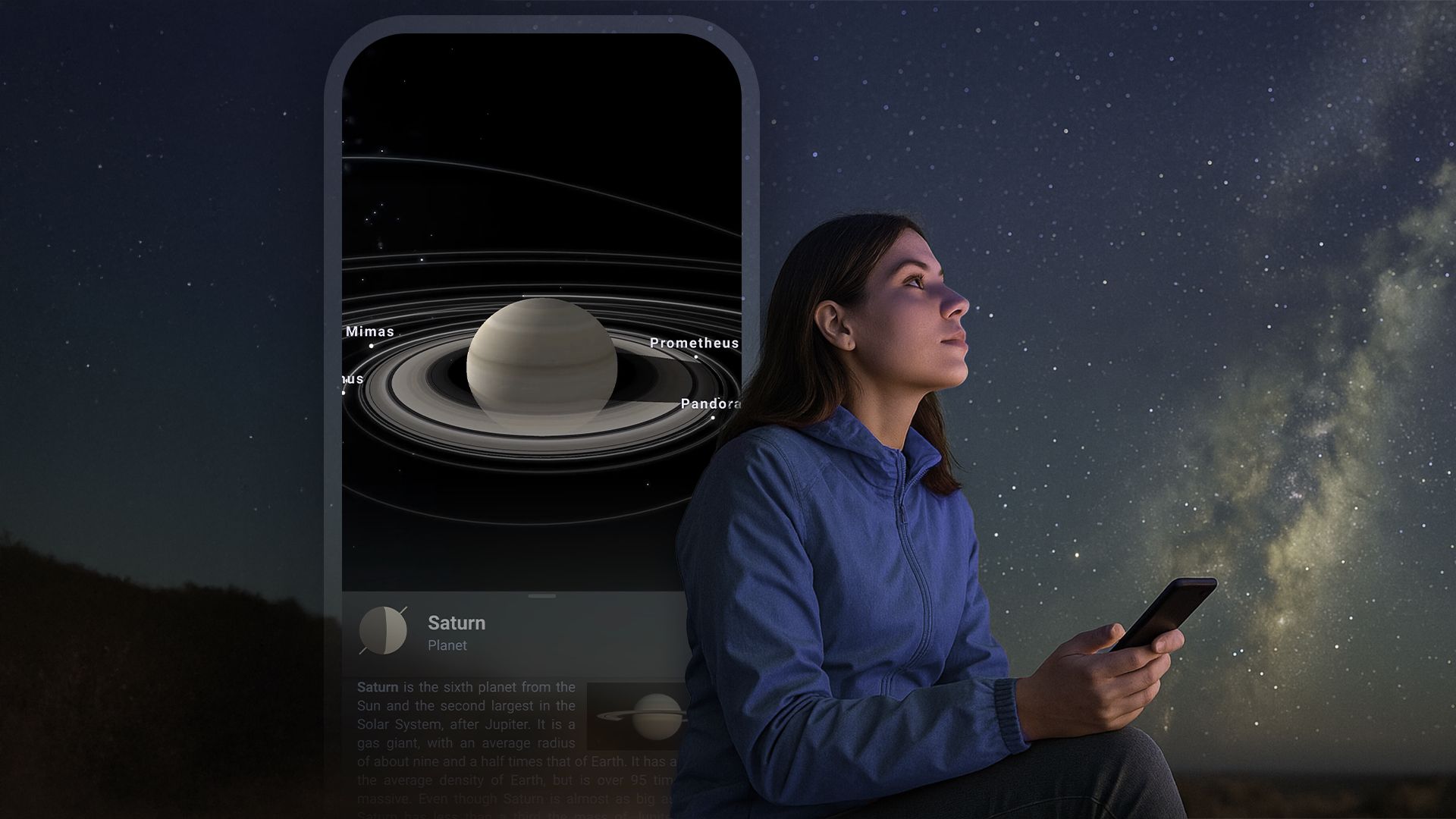Explore the Night Sky with Your Smartphone
You don’t require a telescope to marvel at the celestial wonders above; your smartphone can reveal what’s visible in the night sky. With the appropriate application, you can simply point your device at the heavens and identify stars, planets, and other celestial bodies in real time, all while tracking their movements.
SkyView
SkyView stands out as an intuitive augmented reality application designed for identifying stars, planets, satellites, and constellations. The full version, available for both Android and iOS devices, comes at an affordable price, with a slightly higher cost on iOS. A free lite version is also accessible, allowing users to experience its functionality before making a purchase. Both versions utilize your smartphone’s camera and compass to accurately overlay celestial objects in your field of view, functioning without the necessity of a telescope or data connection.
This application enables you to tap on objects to learn more and save your favorites for easy access later. Key features include a night mode that maintains your night vision and reminders for celestial events. While the user interface is user-friendly, some users report that certain objects may disappear too quickly. The paid version augments the experience, including additional stars, constellations, satellites, and engaging animation of constellation art. Whether you’re camping, hiking, or stargazing from your backyard, SkyView is an excellent choice for learning about the cosmos without the complexities of astronomy terminology.
Stellarium
Stellarium is a well-respected planetarium program that accurately reproduces the night sky, showcasing stars, planets, deep-sky objects, and constellations in real time. Its mobile application aligns with the high standards of its desktop counterpart, requiring neither telescope nor connectivity. The free version, called Stellarium Mobile (available for iOS and Android), allows real-time identification by directing your phone toward the sky. It features a night mode to help maintain your night vision, an uncluttered interface, and basic introductory information; however, deep-sky visuals can lack detail, and advanced features are somewhat limited.
For those seeking a more extensive experience, the paid Stellarium Plus version broadens the database significantly, including the full Gaia DR2 star catalog with approximately 1.69 billion stars and millions of nebulae and galaxies. This upgrade also introduces telescope compatibility, satellite tracking, and a celestial calendar, with enhanced image quality and more detailed information on cosmic objects. Users can even travel through time to see how the sky’s appearance changes. The upgrade options differ between iOS and Android, with iOS allowing in-app purchases, while Android users are required to download a separate app.
Star Walk 2
Star Walk 2 offers an appealing blend of aesthetic appeal and fundamental astronomy education, enabling users to explore the skies without needing an expensive telescope. The application functions as a real-time sky map, superimposing constellations, planets, and satellites over your camera perspective, making identification straightforward, even from your backyard.
A time-travel feature allows users to witness the night sky’s evolution across minutes, hours, or even centuries. The night mode incorporates red-tinted text to protect your vision, accompanied by a visual filter that provides access to various wavelengths, showcasing celestial objects usually invisible to the naked eye. While the free version provides ample content, an optional paid upgrade expands access to deep space objects, satellite tracking, and educational cartoons aimed at children.
Be cautious not to purchase individual upgrades in the free version if you plan to switch to the full paid application, as these do not transfer. Specific celestial objects, such as the Andromeda Galaxy, may necessitate further in-app purchases even after acquiring the paid version.
Sky Tonight
Sky Tonight distinguishes itself by simplifying the user experience for non-telescope stargazers. Its clean, real-time sky map presents an accurate depiction of celestial objects directly in your view. The app is available for free on both iOS and Android, with options for in-app upgrades.
While the augmented reality views are commendable, the app excels in providing essential information such as moon phases, sunset times, light pollution levels, and weather conditions, ensuring users can ascertain whether it’s worth heading outside to stargaze. You can tap any object for details about visibility and historical context. Notably, the app includes alerts for significant celestial events and lets you filter objects based on visibility criteria. Although the night mode is somewhat hard to locate in the settings, these minor drawbacks do not detract from its overall efficacy for quick stargazing.
NASA App
The NASA app, while not a conventional astronomy tool, offers resources that could interest casual stargazers. Users can follow the International Space Station (ISS), watch live spacewalks, and explore what happens above the clouds—all without any cost involved.
The ISS tracker sends alerts tailored to user preferences, serving as a basic tool to help spot the ISS using your phone’s camera—although such functionality is limited to the iOS version. The app is more focused on delivering a plethora of space-related content rather than real-time identification of celestial bodies. It features live streaming of NASA TV, high-definition launch videos, podcasts, and a gallery of images showcasing daily astronomical phenomena. The interface is user-friendly, although some parts feel clunky and lack a dedicated night mode.
Star Chart
Although not the most visually striking astronomy application, Star Chart efficiently fulfills its purpose, enabling users to point their device skyward to determine what they are observing. Its augmented reality tracking operates without an internet connection and includes around 120,000 stars and 88 constellations, along with the major planets and the complete Messier catalog of deep-sky objects.
The app also provides a view of objects below the horizon, and its Time Shift feature allows users to navigate up to 10,000 years into the past or future. While the interface is straightforward, in-app purchases are available for added features like tracking comets or satellites.
ISS Detector
Focusing specifically on the International Space Station, the ISS Detector app offers users precise information on when and where to look for the ISS. It provides customizable alerts and helps guide you with a built-in compass, eliminating the need for technical expertise or extra equipment.
The basic version covers tracking for both the ISS and China’s Tiangong space station, with optional in-app purchases extending its capabilities to include Starlink trains and additional satellites. Although it does not provide a star map, the app caters to users who simply wish to spot high-speed phenomena in the night sky.
In conclusion, these applications showcase the impressive capabilities of smartphones in enabling amateur astronomers and casual stargazers to explore the night sky without any elaborate equipment. With a variety of options available, each app provides unique features and experiences, satisfying different levels of celestial curiosity.




